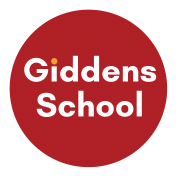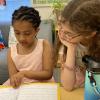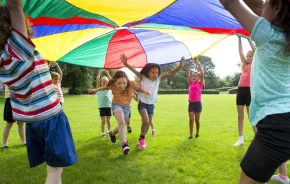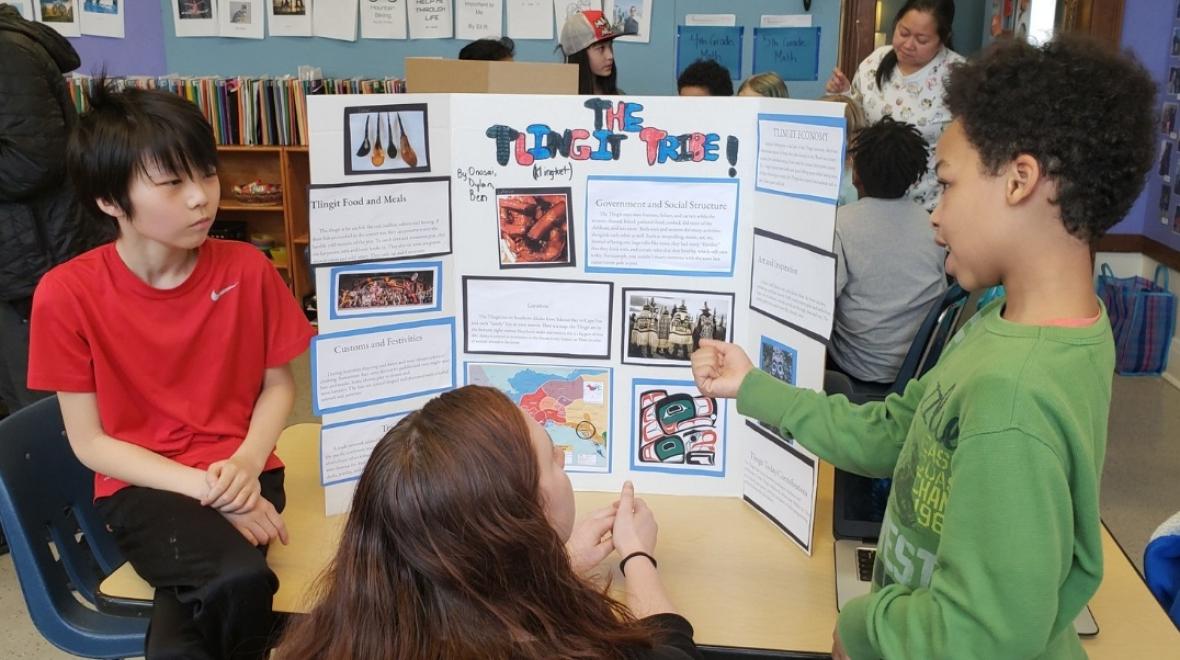
Photo:
Students at the Giddens School review a lesson on the Tlingit Tribe of Alaska. Credit: Eliza Truitt
Editor's note: This article was sponsored by the Giddens School.
By now, everyone knows how important STEM education is. Science, technology, engineering and math (comprising the concept of STEM learning) are the foundations of most of the jobs that will be available for our kids when they eventually enter the workforce. Art instruction, while enabling fewer immediate job prospects, teaches the flexibility of mind that enables individuals to excel in STEM fields and beyond, and is an important component of a life well lived. But it’s one thing to recognize the importance of these subjects, and another thing entirely to teach them effectively. The Giddens School, a preschool–grade 5 independent school in Seattle, has developed a holistic approach to STEAM education. They call it SPARK.
The SPARK learning model
SPARK stands for “Science, Project-based, Art, Relationships, Knowledge.” Science and art are shared with the popular acronym STEAM, but it’s not a one-to-one replacement for STEAM. And it doesn’t mean the other STEAM subjects are neglected. Unlike STEAM, Giddens’ SPARK model is not a simple list of critical classroom subjects.
“It’s both a framework and a curriculum based on the philosophy that all learning should be transdisciplinary. We really want to help students see connections that exist in the world,” explains Sarah Berkley, a Giddens’ teacher who coordinates and plans SPARK curricula with fellow classroom teachers. Using the natural connections among multiple disciplines, including science, social studies and art, SPARK units are inquiry-based learning experiences that explore transdisciplinary knowledge from a social justice foundation.
For example, a unit on Seattle’s Duwamish River blends science and social studies by exploring not only the natural ecology of the river, but also the historical connections between the river, Indigenous people and European colonization. Social justice is added to the mix when students learn that today the Duwamish River is a Superfund site and that the Duwamish people are still struggling for federal recognition. Students then develop projects to answer the question, “What can we do to help right those wrongs?”
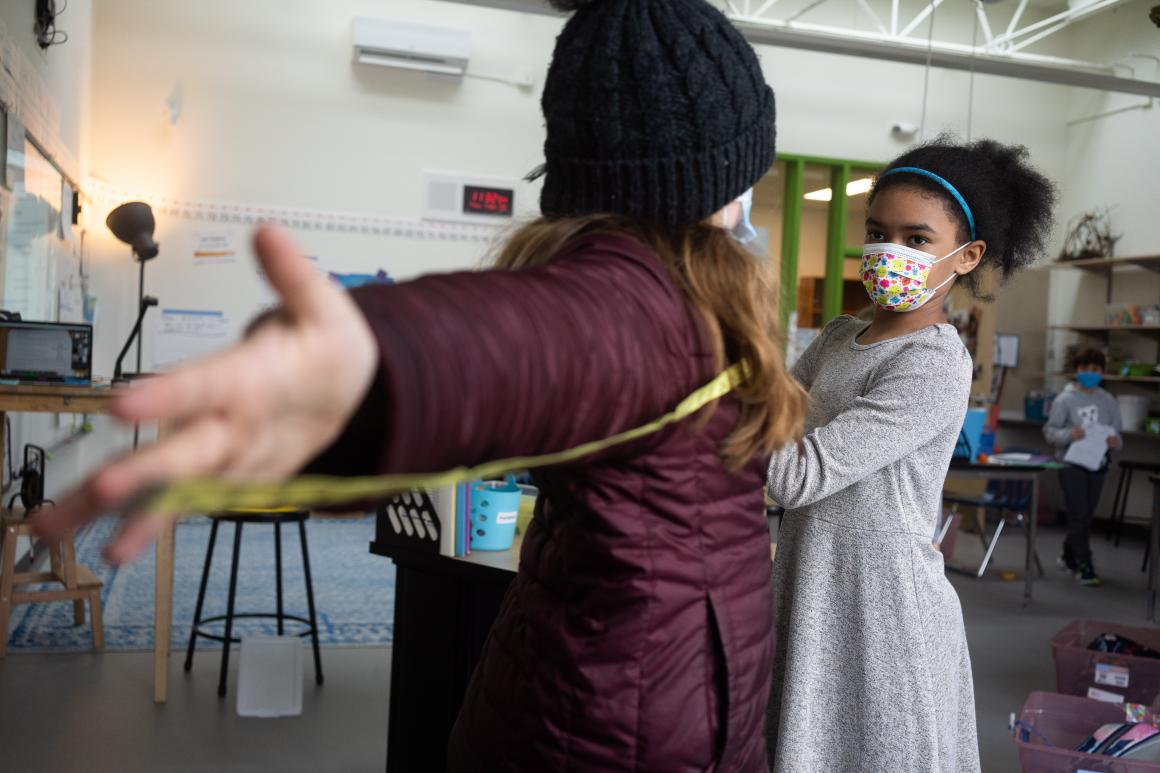
Science in SPARK
Integrated project-based units provoke students to think deeply and broadly, developing their abilities to understand how to apply scientific concepts to real-world challenges from a social justice perspective.
“Science is a central discipline featured in SPARK. For elementary-age students, the goal of science learning is about building content knowledge as well as learning to ‘think like a scientist,’” notes Giddens’ Head of School Morva McDonald.
Project-based learning
“All SPARK units involve at least one ongoing project as a team, individually, sometimes as an entire class. It’s this approach where kids really immerse themselves in a topic,” says Colin Anderson, a fifth-grade teacher at Giddens. Students’ projects evolve from an inquiry-based approach, starting with what kids already know and their own questions about the subject.
“To a large extent, those questions drive much of what we do,” says Anderson. This inquiry-based process is the exact same as the one employed by scientists and engineers. Project-based learning develops the critical thinking skills that are central to those fields. But it’s also the way that kids naturally learn.
“A lot of SPARK units can be easily interwoven into the rest of the day,” says Samara West, a preschool teacher at Giddens. Although each unit is rooted in state standards, when something captures kids’ interest, “We can expand on it with projects and find the connections with science, math or literacy, and bring those in. Because it’s coming from their interests and is something they are excited about, and because it’s so hands-on, the younger kids really connect to it easily,” she notes.
“In education, we know that trying to fill children with knowledge does not work,” says Berkley. “You can tell them facts, but what they’ll remember is a tug-of-war with uneven sides.” When second-graders experiment with team sizes in tug-of-war, they are gaining the experiential context for classroom knowledge about physical forces. When fourth-graders study elections and voting rights, they practice making group decisions by planning a classroom party. Kids are heavily invested in this real-life lesson in government systems, so the knowledge they gain stays with them for life.
Artful encounters
While many schools struggle to incorporate art instruction at all, SPARK learners at Giddens practice art skills in creative projects that are threaded throughout almost every unit.
“What’s cool about including art is that it’s also an assessment tool to show us what kids are learning. And the other piece is that the art also merges with social justice and becomes a form of activism,” says Anderson.
Berkley shares an example. The fourth and fifth grades study a unit on inventions. A few years ago, when they displayed a timeline they had made of historical inventions, the second- and third-graders noticed that all the inventions featured were made by men. The students wrote a letter to the upper grades pointing out the oversight. Then, when their turn came to study inventions two years later, they filled the halls with artwork exclusively focused on female inventors.
Relationships
SPARK relationships have multiple facets. Aside from the connections among subjects, there is the relationship-building and social-emotional learning that comes from working on group projects.
“Sometimes, it’s the first opportunity they’ve had to work in teams. They’re getting the opportunity to learn how to collaborate with peers,” says West. Students get to explore their own strengths and learn to appreciate others’ accomplishments. West describes a unit on movement in which preschoolers constructed ramps for vehicles. Students were excited to see their peers succeed, and new friendships developed over shared ideas to make their cars go faster.
“Our youngest students have another science unit on light and colors where they mix different colors to make new ones, and also observe how all of our different beautiful skin tones are blended from different colors,” says Berkley.
West adds that the unit incorporates social justice — relationships on a societal scale — by addressing the negative connotations of darkness that harm people.
“It builds empathy and understanding of differences, and that is really the basis for social justice,” she says.
SPARK at home
Parents can take a SPARK approach at home, too, by giving their kids an opportunity to explore whatever sparks their child’s interest. Parents can help them immerse themselves in a subject by providing a variety of resources and teaching them how to discover more on their own. Where possible, they can help their children discover and explore the relationships between their interests and the lessons they are learning at school. This helps kids find a way to turn learning into action. Ask your child, “What can we do as a family to have an impact on this?”
“Think about learning as an experience and approach it in a playful way. Whatever a child is interested in is an opportunity to learn, and as long as they’re having a really wonderful experience, they’re going to learn more,” encourages West.
Helping kids pursue their own questions through hands-on activities not only prepares them for STEAM careers, but it also builds a foundation for engaged citizenship.
|
Sponsored by: |




